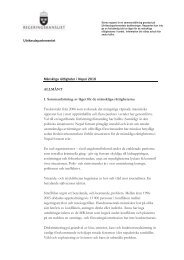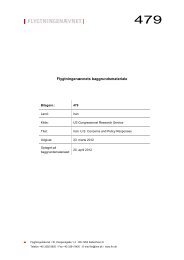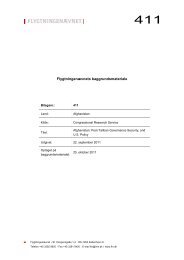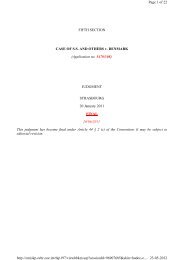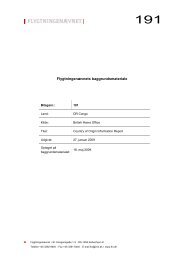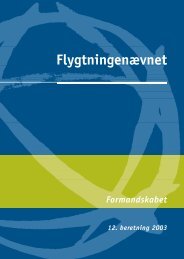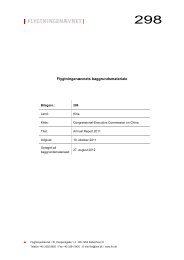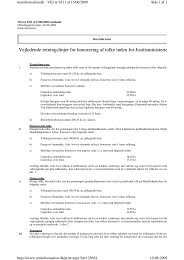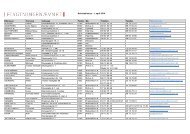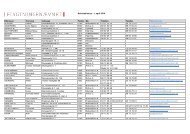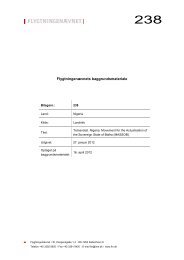Annual Report - National Human Rights Commission
Annual Report - National Human Rights Commission
Annual Report - National Human Rights Commission
Create successful ePaper yourself
Turn your PDF publications into a flip-book with our unique Google optimized e-Paper software.
Annexure 12<br />
○ ○ ○ ○ ○ ○ ○ ○ ○ ○ ○ ○ ○ ○ ○ ○ ○ ○ ○ ○ ○ ○ ○ ○ ○ ○ ○ ○ ○ ○ ○ ○ ○ ○ ○ ○ ○ ○ ○ ○ ○ ○ ○ ○ ○ ○ ○ ○ ○ ○ ○ ○ ○ ○ ○ ○ ○ ○ ○ ○ ○ ○<br />
○<br />
institutionalise the functioning of these nodal officers from all states. The national agency could<br />
function as the special rapporteur-cum-coordinator of all activities related to anti-trafficking.<br />
Since this agency can facilitate counter-trafficking activities across all states, the states should be<br />
willing to be associated.<br />
NGO Coordination at the <strong>National</strong> Level<br />
At present, NGOs function not in unison, but disparately. There is a need for coordination<br />
among the NGOs within the states, across the states and across the borders. As of today, the<br />
trans-border networking of selected NGOs (for example, SANLAAP, SLARTC, etc. from India,<br />
BNWLA from Bangladesh and Maiti from Nepal) is functioning well. Similarly, NGO networks<br />
like ATSEC and NASCET have established effective linkages. However, it is appropriate and<br />
essential to set up a national integrated grid of the NGOs on anti-trafficking, which is linked<br />
with the NGO groups across the borders in Nepal and Bangladesh. This could perhaps be<br />
facilitated by an MOU similar to the one in Thailand.<br />
GO-NGO Partnership<br />
Collaboration of NGOs and government agencies is an essential requirement in the anti-trafficking<br />
programmes and activities. The national nodal agency mentioned above could facilitate such<br />
collaboration. It should, however, be borne in mind that the government agencies cannot abdicate<br />
their responsibility and, therefore, the role of NGOs would be only complementary and not<br />
supplementary. However, in order to achieve best results from community participation, certain<br />
specific activities such as setting up rescue homes and counselling centres could be delegated to<br />
the NGOs. The Andhra Pradesh model of co-management of rescue homes and having<br />
coordination committees at the state and district levels is a good example. At many places, the<br />
police faces acute shortage of personnel, particularly women police, and resources to cater to<br />
such requirements. Therefore, despite court orders, repatriation gets unusually delayed. The<br />
Tamil Nadu practice of involving NGOs in the process of repatriation, by providing adequate<br />
resources to them, has been found to be effective. Similar examples could be thought of by other<br />
states. Notifying them, as stated earlier, in the advisory body u/s 13(3) (b) of ITPA could strengthen<br />
the partnership of NGOs. At the national level the NGO grid, discussed above, could be dovetailed<br />
to the <strong>National</strong> System of Nodal Officers on Anti-Trafficking, which has been set up by the<br />
NHRC. The initiatives for integrating the national network of NGOs and nodal officers should<br />
be facilitated by the NHRC.<br />
Corporate Response<br />
The research has shown that, of late, the social responsibility of the corporates has given a strong<br />
impetus to anti-trafficking activities. The illustrations presented in the study explain the scope<br />
and potential of the role of corporates not only in providing financial resources, but also reducing<br />
the vulnerabilities which lead to trafficking. Therefore, they have a large role to play in preventing<br />
trafficking. The partnership of corporates with NGOs can be initiated by either party or could be<br />
facilitated by the concerned government agencies. The large amounts which corporates<br />
272<br />
<strong>National</strong> <strong>Human</strong> <strong>Rights</strong> <strong>Commission</strong> <strong>Annual</strong> <strong>Report</strong> - 2004-2005<br />
AR-Chapter-1-19-10-6-06.p65<br />
292<br />
7/17/06, 6:31 PM



